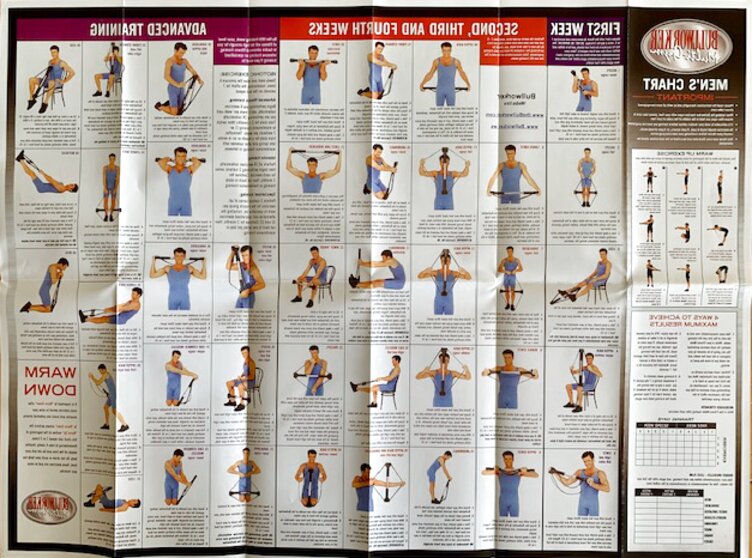


Two opposing cables are attached to the hand grips at each end of the device. The original Bullworker device consists of two sleeved, spring-loaded, telescopic cylinders in the center, with two hand grips affixed at the outermost ends. A further object is to provide an exerciser which the user may manipulate with his hands and feet and may also support against the floor, wall or ceiling of a room". Another object is to provide an exerciser of simple and robust construction which is safe against accidents. It is an object of the invention to provide an exerciser usable by compression, pull and expansion. "The invention relates to physical exercisers, and more particularly to a device for human use by which a large variety of physical exercisers for training and strengthening the muscular system of the body may be carried out.
BULLWORKER X5 EXERCISES PORTABLE
Kölbel used and enhanced the devices of Pons and Chapman to create the Tensolator which became the Bullworker, a portable home fitness device and the seven second isometric exercise principle for the fastest strength gains, using both contraction and extension movements involving range of motion for all the major muscle groups, into one lightweight and compact fitness tool at a price everyone could afford. The Tensolator and the first Bullworker device However, the original article is far more complex even if it showed significant gains after a 4 week program of isometric exercises.
BULLWORKER X5 EXERCISES MANUAL
The Bullworker manual claimed that study resulted in the isometric training group improving three times faster than the sports training group on tests measuring increases in strength, endurance, coordination, and agility. Baley put isometrics to the test with a class of 104 college students at the University of Connecticut. They both developed a training program based on isometrics exercise. Theodor Hettinger published his book Physiology of Strength. The study at the Max Planck Institute consisted of over 200 experiments over a ten-year period. Furthermore, it is said that he concluded that muscle growth can be attained by exerting 60% of existing muscle strength against a superior resistance for only seven seconds once a day, a fitness technique known as isometrics. If the contraction of a muscle exceeds one third of its maximum strength, its mass grows and hence also its strength". Erich Albert Müller and Theodor Hettinger "observed that contractions involving less than about one third of maximum strength do not train the muscle. A minor object is to provide locking means for transport or storage of the device, and other objects will become apparent, more especially in relation to economical and convenient constructional features". Again, an object is to provide simple means Whereby the adjustment at the time being may readily be observed. A further object is to provide such an exerciser with a degree of adjustability so that as the user's physique improves the effort he has to exert may be increased. An object of the invention is to provide an exerciser usable by compression between the hands or parts of the body or limbs. "The invention relates to physical exercisers for human use, and seeks to provide in a single device means whereby a large variety of beneficial exercises for the body and limbs may be carried out. Arthur William Chapman Ī second device, invented in 1937 by Arthur William Chapman would be used to create the Bullworker. The objects of the invention are to devise a portable exercising apparatus particularly for the development of the chest and arm muscles, suitable for both old and young persons by reason of the interchangeability of the resilient member and generally to provide an exercising apparatus to be operated by the hands and arms, simple in construction, cheap to manufacture, durable and interchangeable as to its parts". "The invention consists essentially in the novel construction and arrangement of parts whereby spring controlled telescopic members are embodied in an exercising apparatus in a special manner more particularly described hereinafter. It consisted of three sleeved, spring-loaded, telescopic cylinders in the center, with two hand grips affixed at the outermost ends. The device looked quite like the first bullworker to come (without strings). The original device was patented in 1912 by an American Citizen from Brooklyn, Arthur A.


 0 kommentar(er)
0 kommentar(er)
